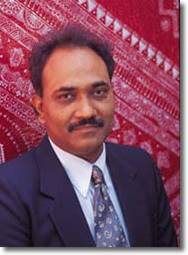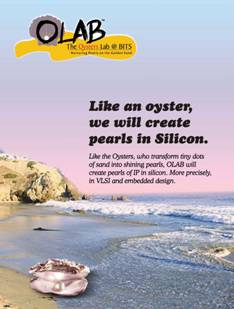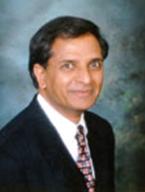It was
2002 – and the 1977 batch alumni were gearing up for
their silver reunion.
Amidst all the hectic planning and excitement, a
few members thought it would be a nice idea to give back
something to the college they owed so much to. Ideas
floated around, and the one that stuck was that of a
world-class VLSI Laboratory. A year later, in July 2003,
at the music night in
Bangalore
- BITSConnexion, in the
melee of songs and handshakes, this idea took shape and
form. Few more months later, with the efforts of some
well-placed alumni in the VLSI industry in
Bangalore
, a presentation was
given to current Vice Chancellor of BITS, Dr S.
Venkateshwaran. OLAB was to be a world-class laboratory
in terms of infrastructure, facilities and talent.
 We
spoke to Vinod Agarwal (68’ EEE), Founder &
Chairman of LogicVision (publicly traded embedded test
company on NASDAQ) and Rajendra Khare (‘77 EEE,
pictured above), Managing Director of BroadCom
India
– doyens in the VLSI field and captains of the OLAB
initiative.
We
spoke to Vinod Agarwal (68’ EEE), Founder &
Chairman of LogicVision (publicly traded embedded test
company on NASDAQ) and Rajendra Khare (‘77 EEE,
pictured above), Managing Director of BroadCom
India
– doyens in the VLSI field and captains of the OLAB
initiative.
“OLAB stands for
Oyster Lab At BITS”, says Raj. The term oyster is
meant to indicate the environment and various processes
that go into culturing pearls from sand.
Which, in BITS terms, refers to converting the
unrefined students’ capabilities into unmatchable
intellectual property in the silicon world - all in good
ol’ Pilani.
VLSI and semiconductor
design is a huge engine of growth for
Silicon Valley
. It also
has strong links to Indians, since many have founded and
worked in the Valley in this field.
The chief architect of Intel’s Pentium chip was
an Indian. However,
in
India
, where the focus has been Software and IT, VLSI and
semiconductor design has been ignored by the mainstream
of engineers and entrepreneurs.
 There
are rational reasons for this.
Firstly there are few specialized institutions in
India
to train people in this field. There is no fab (factory
to manufacture chips) in
India
either. In
countries like US,
China
,
Malaysia
and
Taiwan
, there are many fabs, which has created investment in
training, research and more startups.
There
are rational reasons for this.
Firstly there are few specialized institutions in
India
to train people in this field. There is no fab (factory
to manufacture chips) in
India
either. In
countries like US,
China
,
Malaysia
and
Taiwan
, there are many fabs, which has created investment in
training, research and more startups.
However, fables design
is perfect for
India
, since it requires only investments in human capital
and can easily follow the outsourcing model.
India
also has many successful VLSI/chip-design entrepreneurs
and experts in the Valley. There is a deep pool of
talent with ideas looking to do something with
India
.
Vinod Khosla
,
India
’s best known VC has moved to
India
and is generating interest with investments in the
field.
As VLSI becomes a
mainstream field in
India
, there will be a tremendous need for world-class
training facilities, which is what prompted Vinod and
Raj to set up a lab with world-class infrastructure.
Partnering with BITS made sense with its faculty,
alums, talent, resources, linkages to industry and most
importantly, experience in training.
Raj believes that with its world class
infrastructure and with the proper guidance, students
should be able to conduct cutting edge research, which
would focus on real world problems and produce
competitive, commercially viable solutions.
Eventually trained professionals would go off to
work for MNCs in
India
, domestic start-ups or create their own companies,
putting
India
on the world silicon map.
Thanks to the excellent
personal efforts of Raj and Vinod, BITS has received $50
million worth of expensive tools from Mentor Graphics
& Magma Design Automation and other high-priced
workstations and servers from Sun Microsystems. The
tools now in BITS are really up to the mark and
comparable to any professional set up in the silicon
industry. Now the Neuron Network also empowers you to
connect to a centralized facility which, along with OLAB,
would be a very powerful combination.
Tons of alums have
pitched in to help from
Bangalore
and
Delhi
. They are
helping to fulfill the requirement of design experts
from the real world who can help BITS students get the
full benefits of
 OLAB’s
world class infrastructure.
OLAB’s
world class infrastructure.
 The
key players, VLSI engineers with a rich experience of
5-6 yrs in the field include Nagesh
Chatekar from BroadCom, Deepa
J from Cypress, Sriram
R from TI, Karthik Kandaswamy from Wipro. Anurup
Mitra and Kallol
Chatterjee from ST. Dr.
Anand Bariya from Toshiba is also playing a major
role in helping with cell libraries and other design
needs. The
building blocks required for the projects have been
given by these key players, as we call them, and they
have been very instrumental in creating and formulating
the actual projects that the students have to work on.
Presently there are also about 5 project assistants, ME
students at BITS, who will help give the continuity that
is required to carry forward the work for a
significantly long time. There are even plans that the
OLAB infrastructure may be used for PhD programs in
BITS. The VLSI engineers and key players involved have
also traveled to BITS, surveyed the lab and are now even
having weekly conference calls.
The
key players, VLSI engineers with a rich experience of
5-6 yrs in the field include Nagesh
Chatekar from BroadCom, Deepa
J from Cypress, Sriram
R from TI, Karthik Kandaswamy from Wipro. Anurup
Mitra and Kallol
Chatterjee from ST. Dr.
Anand Bariya from Toshiba is also playing a major
role in helping with cell libraries and other design
needs. The
building blocks required for the projects have been
given by these key players, as we call them, and they
have been very instrumental in creating and formulating
the actual projects that the students have to work on.
Presently there are also about 5 project assistants, ME
students at BITS, who will help give the continuity that
is required to carry forward the work for a
significantly long time. There are even plans that the
OLAB infrastructure may be used for PhD programs in
BITS. The VLSI engineers and key players involved have
also traveled to BITS, surveyed the lab and are now even
having weekly conference calls.
 The
current projects are now small pieces of the big puzzle
which is the ZigBee technology. ZigBee is considered as
the next revolution in wireless technology by industry
leaders. This technology is very new and has a lot of
scope- dealing with wireless interaction between
networks. In short, an implementation of what we have
been projecting as non-working models in APOGEE for
years now. The
next major milestone for OLAB would be an integration of
all the projects to give a successful solution to the
ZigBee, which might even be commercially successful.
BITS could collaborate with foreign universities like
the
University
of
Berkley
who are
currently working on ZigBee.
The
current projects are now small pieces of the big puzzle
which is the ZigBee technology. ZigBee is considered as
the next revolution in wireless technology by industry
leaders. This technology is very new and has a lot of
scope- dealing with wireless interaction between
networks. In short, an implementation of what we have
been projecting as non-working models in APOGEE for
years now. The
next major milestone for OLAB would be an integration of
all the projects to give a successful solution to the
ZigBee, which might even be commercially successful.
BITS could collaborate with foreign universities like
the
University
of
Berkley
who are
currently working on ZigBee.
All this has not been
easy. One of
the main problems they faced in Pilani is that it has
taken a while to get the relatively laid back students
(like we were) used to the grilling timetables,
schedules and demands of the Industry. But things have
improved, says Raj, for once OLAB went live, people have
begun to show enthusiasm and support for working
demanding hours. One other problem is that faculty
themselves are not as exposed to this field, in Pilani
or even India since there are so few people exposed to
field. Prof
Gurunarayanan, who
heads this initiative and Dr. L.K Maheshwari have
been extremely helpful on this initiative. They have
extended their full support and cooperation to alums Kallol
Chatterjee and Anuroop Mitra who have
traveled many times to Pilani to guide and help the
students.
Vinod, who along with
Raj will guide and nurture OLAB closely, says “There
is a necessity of people, design experts and others with
experience in the semiconductor industry”. He adds
that “People should visit BITS, get involved and to
help in knowledge transfer. World-class tools will not
be of much help without world class teachers”
Grand plans are
underway. An
extension center is being set up in
Bangalore
that will become
India
’s leading training and research center for VLSI
training for professionals in industry, with close
linkages for commercialization of research.
It will also be open to non-BITSians and utilized
as a PS II center as well.
Raj This
emphasis on VLSI integrates well with the recent grant
by the DoE to BITS for Rs. 2 crores to set up a
Technology Business Incubator that will be a center of
excellence in creating VLSI and embedded software
start-ups.
When
India
becomes a superpower in the field of semiconductors,
BITS, OLAB, Vinod, Raj and all those who are involved
would have played an important role in creating that
history.
For
alumni who have crossed borders and shores to teach,
study and work in the silicon industry, this might be a
good chance to get involved with their alma matter in
something of interest, and give back a little of what
they got to BITS and to India.
If you are interested, sign up at the yahoogroup
which has over 80 alums.
Search on www.yahoogroups.com
for bitsaa-olab to
volunteer for this initiative.
■
|
(c) Copyright 2004 BITSAA International Inc. |
|
Website
by jPeople, YonEarth
and BITSAA Technology |

